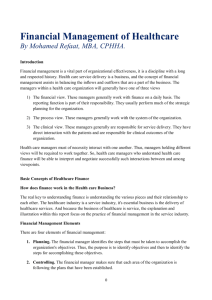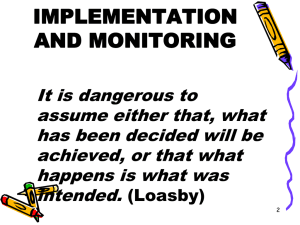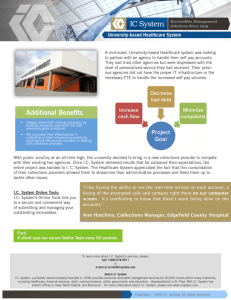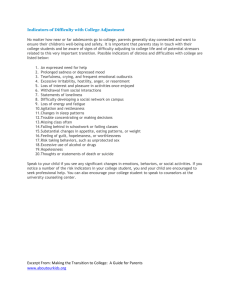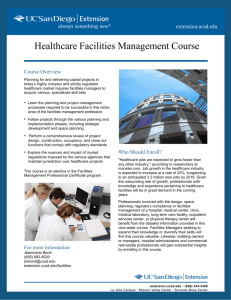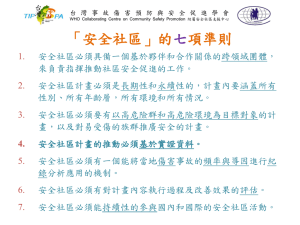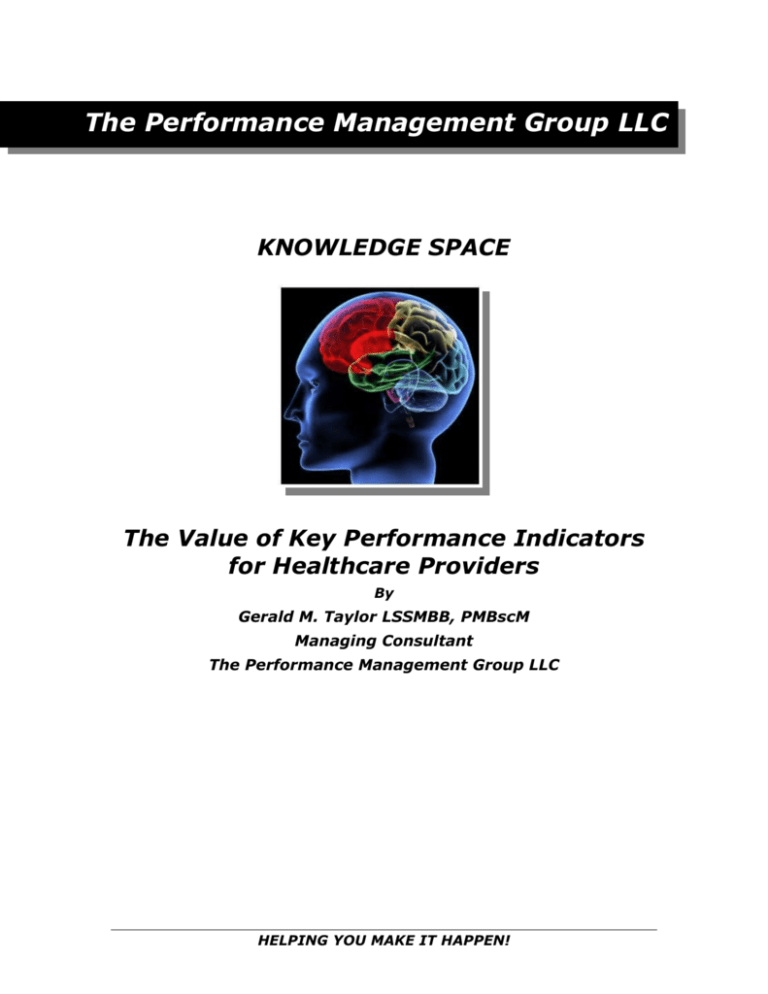
The Performance Management Group LLC
KNOWLEDGE SPACE
The Value of Key Performance Indicators
for Healthcare Providers
By
Gerald M. Taylor LSSMBB, PMBscM
Managing Consultant
The Performance Management Group LLC
HELPING YOU MAKE IT HAPPEN!
Copyright © The Performance Management Group LLC, Inc. 2012
All rights reserved. No part of this guide
may be reproduced in any form or by any
means without permission in writing from
The Performance Management Group LLC.
Published by:
The Performance Management Group LLC
P.O. Box 44989
Phoenix, AZ 85064
HELPING YOU MAKE IT HAPPEN!
The Performance Management Group LLC
TPMG’s mission is helping organizations create and sustain more value.
Founded in 1997, TPMG LLC works with executives, middle managers and front line employees
to help organizations realize greater returns for its stakeholders through customer intimacy,
strategy and operational excellence. Our clients have historically improved their performance by
a measure of 4:1 hard dollar return on consulting dollars invested.
Who we work with
Our clients are ambitious private sector organizations and non-profit government institutions
interested in generating greater performance from their organizations. They may be in the
planning stages of business transformation, interested in developing a superior strategy, or
simply looking to make substantial improvements. Either way, they are not satisfied with the
status quo.
What we do
Our consulting services are concentrated in the following areas of practice:
•
Strategy: helping organizations design, align and execute winning strategies.
•
Process: streamlining processes and improving productivity of organizations.
•
Operational Excellence: training and implementing six sigma and operational excellence
programs.
•
Performance Management: designing and deploying performance dashboards, balanced
scorecards and key performance indicators.
How we do it
We realize that helping an organization change requires more than analyses and
recommendations. We know that change requires successful implementation. What makes us
different is that we provide the experts to enable change to happen and deliver guaranteed
results!
For more information, please visit www.helpingmakeithappen.com or contact:
TPMG LLC
P.O. Box 44989
Phoenix, AZ 85064
emial: info@helpingmakeithappen.com
Tel: (US) 1.623.643.9837
Leadership Tool: Core Competency Analysis | A Knowledge Space™ Guide to Management and Leadership
Table of Contents
Preface
1
Leadership Tool: Key Performance Indicators
3
Key Performance Indicators – Why Measure?
4
Key Performance Indicators – Pursuing Productivity
5
Key Performance Indicators – Improving Quality
6
Key Performance Indicators - Examples
11
Selected References
13
Leadership Tool: Core Competency Analysis | A Knowledge Space™ Guide to Management and Leadership
Preface
“It is only in the pursuit of perfection can a person,
organization or company catch excellence!”
- Gerald Taylor
TPMG LLC Managing Consultant
To pursue is to follow or take action in an attempt to over take or capture something of value. To
advance along a course of action by applying one’s or an organization’s energy to its chief
interest.
To a private sector company, this pursuit consists of trying boosting revenues,
innovating, improve quality or increasing efficiencies. In the public sector and non-profit arenas,
this pursuit takes the form of productively using assets to create long lasting value for the
common good. Whether in the public sector or seeking profits for shareholders, managers and
decision-makers are seeking for tools to help them make it happen.
The current environment of globalization, intense competition and economic instability has
increased the challenges managers face. Leaders today must be more knowledgeable than ever
as they sort through the options and select the appropriate methods and right management tools
for improving their organizations. They must choose an approach that will help them make the
right decisions which lead to profitable growth and superior performance.
Selection and use of such tools requires an understanding of the strengths and weaknesses of
each tool as well as an ability to successfully integrate them in the right way, at the right time. The
secret is not in discovering a magic bullet. In reality, no such thing exists. What does exist is the
advice and counsel of industry experts. Proper guidance from solid expertise can make all of the
difference between success and professional failure. To help inform managers about the tools
available to them, in 2007, The Performance Management Group (TPMG LLC) launched a
multiyear research project to gather data, facts and information regarding the most proven
methods and best practices in industry. The result of our efforts will be published in successive
guides to managers called, Knowledge Space™.
Leadership Tool: Core Competency Analysis | A Knowledge Space™ Guide to Management and Leadership
1
Preface (Con’t)
The goal of Knowledge Space™ is to provide decision-makers with:
1. An overview and description of different leadership tools and proven practices.
2. An understanding of how the methods are used to bring about favorable results and
compare to other organizations across industries and around the globe.
3. The information they need to identify, select, and integrate the right approach to
improve their organization’s performance.
Knowledge Space™ is a dynamic system of advice and education. It consists of published
guides, blogs, and online instructional workshops.
In Knowledge Space™, leaders will find
research and education which provide a number of important insights including, the extent to
which:
1. Industry leaders are satisfied with certain management practices, their rates of usage,
ease of implementation, and effectiveness.
2. Methods are effective when used individually or when part of a major organizational
effort.
3. Approaches achieve better results.
In our Knowledge Space™ guides, we describe management practices, how they are used,
related topics and the value they offer.
Through our primary and secondary research, we
determine the extent to which each approach is being deployed and its rate of success.
In December 2012, TPMG Educational Services launched Knowledge Space™Blog. In this
blog, you can read free cutting edge research and information regarding leading practices that
are proven to bring about success.
You can converse with leading professionals and gain
practical insight from their experience and comments. You will also find multimedia case studies
and instructional videos that will sharpen your skill sets and help you build your own professional
capital.
In January of 2013, TPMG Educational Services will establish Knowledge Space™ Seminars.
Knowledge Space™ Seminars are inexpensive online self-paced multimedia self-paced AND live
skill building workshops which will help you refresh your credentials and build on your
professional development.
To learn more about Knowledge Space™ products and services contact TPMG Educational
Services at info@helpingmakeithappen.com.
Leadership Tool: Core Competency Analysis | A Knowledge Space™ Guide to Management and Leadership
2
Leadership Tool: Key Performance Indicators
A Knowledge Space™ Guide to Management and Leadership
In this guide, we define the value and use of Key Performance Indicators.
We provide a
compelling rationale for why leaders need to measure; we outline seven best practices for using
quality and performance metrics and then supply real world examples of effective use of quality
and performance metrics. This guide does this in the context of the Healthcare industry.
The Value of Key Performance Indicators for Healthcare Providers
If winning isn’t everything, why do they keep score?
– Vince Lombardi
The quote above embodies the purest notion regarding the nature of work. There is a scale by
which we success is measured and someone is always keeping score. For managers, this
means there is a scale by which the consequences of our decisions and actions are
measured.
Our hope the results of our efforts are favorable for those who entrust us with
decision-making authority. In a profit seeking organization, shareholders, employees and
customers measure the outcomes of the decisions we make and the actions we take. In
government, this task is given to the voting public. For non-profits, managers are brought to
account by fundraisers, contributors and the beneficiaries of their organization’s services.
In the world of healthcare, the ultimate trust is that which exists between patients and
providers.
When patients require care, they rely on medical experts to provide the right
diagnosis, early and timely treatment, and the best conditions for a complete recovery. And yes,
they too are keeping score.
Leadership Tool: Key Performance Indicators | A Knowledge Space™ Guide to Management and Leadership
3
Leadership Tool: Key Performance Indicators
Why measure?
This writer can think of at least 100 reasons why a healthcare leadership team should design and
deploy a performance measurement system. For the goals of this article, we will concentrate on
the most important motivations.
Why measure? First, a healthcare leadership team should deploy a measurement system to
reinforce their organization’s mission. A common joke about measurement systems is, “If we
didn’t measure things, we wouldn’t know how good we are at measuring the things we are
measuring!” Yes, a measurement system should have a purpose. Secondly, a healthcare
leadership team should deploy a measurement system to promote a reduction in medical errors
and work process perfection. A study recently conducted to identify medical errors asserts that
as many as 90% of hospital mistakes go overlooked. Finally, a good healthcare measurement
system will associate patient outcomes with the performance and protocols of the system’s
experts. Accuracy, accountability and purpose are three essential characteristics of a healthy
performance measurement system, but the number one reason a healthcare organization should
deploy key performance indicators can be summed in one word = PRODUCTIVITY!
Now, more than ever, the healthcare industry needs to embrace the economic value proposition
of improving productivity. For the past 20 years, the industry has experienced anemic
productivity growth while healthcare labor productivity actually decreased by 0.6% annually. The
economic consequences of this type of industry performance are stunning. U.S. health care
costs currently exceed 17% of GDP and continue to rise. A PricewaterhouseCoopers report
projects that health care costs will increase 7.5 percent in 2013. That is more than three times the
rate of inflation and the projected rate of US economic growth. That same report also notes that
health insurance premiums are expected to rise 5.5 percent, in large part because employers are
shifting costs to their employees. Medicare’s Office of the Actuary forecasts that health care
spending will jump to more than 7 percent in 2014. At the same time, healthcare providers will
face unprecedented cuts in reimbursement rates from Medicare and other third party payors. The
bottom line is that until true health care cost reform becomes a reality, these pressures will
continue to cause problems for providers, for people’s health care and for the nation’s
economy. Healthcare organizations should use these pressures as motivation to embark upon a
relentless pursuit of ever-increasing productivity.
Leadership Tool: Key Performance Indicators | A Knowledge Space™ Guide to Management and Leadership
4
Leadership Tool: Key Performance Indicators
Why is pursuing productivity so important healthcare providers?
Improving productivity helps providers stay in business and grow. Improved productivity is an
organizational competence that insulates healthcare organizations from destructive actions like
avoid across-the-board cuts in expensive services, staff compensation, and head count. In fact, a
nationwide improvement in productivity among healthcare systems can reverse the negative
economic consequences forecasted on the horizon.
Economists Mark Whitehouse and Tim Aeppel aptly describe the economic value of productivity
growth in a November 3, 2006 Wall Street Journal Article:
“Productivity matters for everyone, because it provides the essential ingredient that makes
nations rich! When companies produce more for each hour their employees work, they can pay
higher wages or reap bigger profits without having to raise prices. Annual productivity growth of
2% would more than double inflation-adjusted wages over 40 years, all else being equal. Add
another percentage point in productivity growth, and wages would more than triple!”
What is Productivity?
Essentially, productivity is defined as output per unit of input. As illustrated in the figure below,
productivity is the difference between the value produced by an organization and the cost of the
basic resources brought to bear in a productive process.
Leadership Tool: Key Performance Indicators | A Knowledge Space™ Guide to Management and Leadership
5
Leadership Tool: Key Performance Indicators
From the perspective of the patient, the ultimate measure of productivity (patient value) is the full
set of favorable health outcomes over the cycle of care divided by the total cost of care of the
patient’s condition.
Healthcare providers can increase productivity by doing the following:
1. Increase the number of patients served (the numerator) while keeping the cost of the
inputs (denominator) fixed.
2. Keep the number of patients served constant while decreasing the cost of clinical and
administrative processes.
3. Accomplish a combination of the two examples above.
Productivity vs. Quality in Healthcare Delivery Organizations
Harvard Professor, Michael Porter argues that quality and performance improvement are key
drivers of cost containment and higher value, where quality is health outcomes. Stated another
way, the drive for better quality of health outcomes and the drive for increased productivity are not
mutually exclusive. In fact, poor quality is not only poor for healthcare outcomes but also creates
a drag on productivity.
Leadership Tool: Key Performance Indicators | A Knowledge Space™ Guide to Management and Leadership
6
Leadership Tool: Key Performance Indicators
The figure below illustrates how poor quality can cause problems for productivity.
It describes
the generic equation of productivity but integrates certain non-productive outcomes organizations
typically produce. Along with salable goods and service transactions, organizations produce
defects, errors, rework, customer credits, fines, accidents, lawsuits etc… These outcomes
describe work products six sigma black belts call the hidden factory; and the costs associated
with them are referred to as the Cost of Poor Quality (COPQ). They reflect the failures and
dysfunctions of organizations and rob industries of the productive use of human and financial
capital.
For healthcare providers, the hidden factory can be found in both administrative and clinical
areas.
A recent study found that medical errors cost Medicare more than $324 million per
month. A USA Today article reported that 80% of medical bills are inaccurate and a 2009 study
conducted by University of Minnesota health finance professor Stephen Parente found up to 40%
of hospital insurance claim statements contain errors. To make matters worse, many patients are
paying a heavy price for the hidden factory. One out of every three people encounter an adverse
event when admitted to a hospital, according to a recent study (4/6/2011) published in the health
policy journal Health Affairs. The study also found that the hidden factory is, indeed, hidden –
about 90 percent of all hospital mistakes go unreported.
The cost of poor quality not only adversely affects patient outcomes (numerator) but also provider
costs (denominator). The High Value Healthcare Collaborative, an organization consisting of 20
major Hospital Groups who serve 70M people, estimate that the cost of the hidden factory is
more than 30% of all healthcare delivery cost. These costs create a significant drag on
productivity.
Leadership Tool: Key Performance Indicators | A Knowledge Space™ Guide to Management and Leadership
7
Leadership Tool: Key Performance Indicators
Why do we measure? We all know that what gets measured gets improved. Healthcare leaders
should deploy a system of quality and performance metrics to control and improve overall
healthcare quality.
Click picture to follow link
Improving Quality
The figure below is an adaptation of the Deming Chain Reaction. It illustrates the affect that
improving quality has on productivity. It states that when provider organizations improve quality,
their costs go down. Their costs go down to the tune of 20 – 40% of total operating
expenses. The decrease occurs because the costs of wasted effort reworking problems,
correcting medical errors, reassuring dissatisfied patients and reconciling invoices are
eliminated. As these costs go down, productivity naturally improves. Productivity improves
because of the increased productive capacity of human capital, technology and working capital in
producing favorable patient outcomes.
Leadership Tool: Key Performance Indicators | A Knowledge Space™ Guide to Management and Leadership
8
Leadership Tool: Key Performance Indicators
Better patient outcomes and the termination of the hidden factory lead to greater profit
margins and enhanced economic value. The additional economic value funds growth
and innovation, which leads to improved healthcare quality and high value jobs.
Quality and Performance Metrics – Best Practices
When designing a system of key performance indicators, an organization should follow seven
proven practices:
1. Metrics should be defined and understood by all within the organization. Operational
definitions help clearly define what is being measured. There are three basic elements of
an operational definition: the measure, the instrument being used, and the procedure for
measuring.
2. Performance metrics should be strategically integrated for tracking daily
operations. Good performance metrics are engineered based on cause and effect
relationships.
In the world of statistics this is called engineering an explanatory
response distinction; where the extent of an outcome is leveraged by the degree of
influence a decision maker’s actions has on organizational processes.
3. Data derived from measurement systems contribute to operational and strategic decisionmaking. This practice supports the principle of management-by-fact where decision
makers not only understand the activities and work products of their organizational
processes, but they also track performance records over time and keep numerical facts
for analysis and decision-making.
4. Metrics should be compared with industry ratios and benchmarks. Comparisons should
represent best practices for similar activities, inside or outside the health care industry.
Such data might be derived from surveys, published and public studies, participation in
indicator programs or other sources.
5. Performance results should be trended over time and communicated cross functionally
and vertically within the organization.
6. Measurements should align with organizational critical success factors and strategic
plans. Doing so empowers leadership to review progress and assess organizational
performance relative to strategic objectives and action plans.
7. Metrics should ultimately impact a financial component. Healthcare delivery
organizations are not immune from the virtues or vices of capitalism; it must create
economic value to sustain itself.
Leadership Tool: Key Performance Indicators | A Knowledge Space™ Guide to Management and Leadership
9
Leadership Tool: Key Performance Indicators
Quality and Performance Metrics an Evaluation
Quality and performance metrics should collect an analyze data on three essential perspectives:
operational excellence, value proposition, and economic value.
Operational Excellence
Operational excellence is defined as the extent to which the core administrative and clinical
functions are managed efficiently. Operational excellence is a key driver of patient outcomes and
economic value. Appropriate metrics should evaluate the extent to which the professional
expertise, technology and protocols deliver care productively. Metrics should track output, cycle
times, cost and defect levels.
Value Proposition
Healthcare delivery organizations primarily extend value to patients, their families and third party
payors. Metrics should evaluate the quality of healthcare outcomes and the degree to which the
outcomes are favorable or unfavorable over the care cycle. They should also measure the extent
to which the needs, attitudes and perceptions of the patient and their families have been served
(patient satisfaction).
Performance metrics should also measure the extent to which
administrative functions satisfy payor requirements.
Economic Value
Key performance indicators should evaluate the extent to which healthcare delivery operations
adequately provide financial surpluses or profits to sustain its operations and fund long-term
growth. Performance metrics should include measures of financial return, financial viability and
budget performance.
Leadership Tool: Key Performance Indicators | A Knowledge Space™ Guide to Management and Leadership
10
Leadership Tool: Key Performance Indicators
Quality and Performance Metrics – Examples
Poudre Valley Health System (PVHS) is a 2008 recipient of the Malcolm Baldrige National Quality
Award. The health system is a locally owned, private, not-for- profit provider to residents of
northern Colorado, Nebraska, and Wyoming.
PVHS has an abundance of performance
measures; this article provides three examples for your consideration.
Example – Operational Excellence Metric
For efficiency, PVHS’s measures OR turnaround times and measures on time first case starts as
a metric for effective resource utilization.
Example – Value Proposition Metric
As the best key performance indicator of cardiac outcomes, PVHS focuses on acute myocardial
infarction (AMI, heart attack) patient mortality rates for six months after hospitalization. This
metric is also viewed as a key measurement of outpatient care provided after discharge.
Leadership Tool: Key Performance Indicators | A Knowledge Space™ Guide to Management and Leadership
11
Leadership Tool: Key Performance Indicators
Example – Economic Value Metric
As a key performance indicator of economic value, PVHS monitors profit per discharge. Profit
per discharge is a critical success factor, which enables PVHS to maintain financial sustainability.
The organization monitors profit per discharge to ensure the viability and sufficiency of
investments for the future.
PVHS uses a comprehensive system of strategic and operational metrics by which to analyze its
operations and progress towards its strategic objectives.
Does measurement work for
healthcare? The market and community it serves has many requirements, among them being
serviceability, high quality care and low cost. PVHS maintains its industry position as a low-cost
provider in its market. Since 2001, the systems charges have been consistently lower than the
competition while its profit per discharge to surpassed the U.S. top 10 percent.
If you are
keeping score, then you understand that PVHS is winning.
Gerald Taylor LSSMBB PMBscM is a Managing Consultant for The Performance Management
Group LLC. He can be reached at info@helpingmakeithappen.com
To learn more about establishing a system of performance metrics, Click:
TPMG Key
Performance Indicators and Dashboards
Leadership Tool: Key Performance Indicators | A Knowledge Space™ Guide to Management and Leadership
12
Selected References
1. Robert Kocher, M.D., and Nikhil R. Sahni, B.S., Rethinking Health Care Labor, N
Engl J Med 2011; 365:1370-1372October 13, 2011DOI: 10.1056/NEJMp1109649,
http://www.nejm.org/doi/full/10.1056/NEJMp1109649#t=article
2. Betty Ann Bowser, New Study Finds Medical Error Rates are Underreported, PBS
News Hour HEALTH -- April 7, 2011
http://www.pbs.org/newshour/rundown/2011/04/new-study-finds-medical-error-ratesare-underreported.html
3. Kelly Kennedy, HHS: Hospitals ignoring requirements to report errors, USA TODAY
Updated 7/20/2012, http://usatoday30.usatoday.com/news/health/story/2012-0719/hospitals-preventable-errors-report/56343348/1
4. The award winning Poudre Valley Application to the 2008 Malcolm Baldrige National
Quality Awards.
Leadership Tool: Key Performance Indicators | A Knowledge Space™ Guide to Management and Leadership
13

